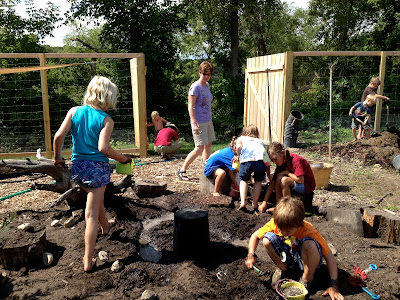Like many museum
professionals, especially in children’s museums, I think understanding and engaging parents is critical to a museum’s achieving its mission and
accomplishing its goals. My sense of parents’ interests has been informed by
three decades of working in and with museums: doing programs, responding to
comment cards, observing parents, conducting focus groups, and exploring
exhibits with them and their children.
Now after spending 4 days
listening to parents in several children’s museums as part of a research
project, I am happy to upgrade my already positive assessment of parents to one
even more positive and better informed by their voices. Parents, regardless of their
child’s age or gender, are thinking about and providing for an amazing
range of considerations about their children and their museum visit. And I
am very impressed.
Some of what I heard was
gratifying and on target with museums’ intentions, but was not necessarily
surprising. Parents consistently mentioned the variety and originality of
structures, materials, toys, and props in the museums. They pointed out recent
exhibit and activity changes and additions. They appreciate staff and view them
as friendly and helpful. They highlighted their child’s concentrating,
pretending, and sharing with other children as something that enhanced their
children’s experience and was enjoyable for them to observe in their children.
They valued the level of
independence and related freedom the museum environment affords a child without
parental hovering. Knowing that other children are supervised by their adults
and knowing the museum has limited and controlled exits are critical for
parents and grandparents to feel at ease as their children explore. Yet, even
when parents appear to be sitting back and uninvolved, they are tuned into
their children and focused on the serious work of being good parents and
grandparents.
• Parents note and mark
their child’s developmental progress over time and in relation to museum
activities and exhibits. Unprompted, parents I talked with mentioned how a
child’s use of a component has changed over several months; an increasing
attention span; doing more activities on her own; or experimenting with
materials in new ways. Parents also express a certainty that a child will be
into something new in a few months.
• Parents deliberately use
what they know their child does naturally–watch them closely and imitate
them–in service of larger goals. A mom will turn a valve in a way that allows
her daughter to see how it works so she can try it herself. An aunt uses the word patterns and notices whether her niece uses the word on her
own. A mother presses a series of buttons deliberately for her son to see she
was making music not just randomly pushing buttons.
• In turn parents are
paying close attention to cues their children give as they explore. They note
what fascinates a child, the emergence of an interest in music, new concepts
their child is picking up, and in which places the child asks more questions.
Parents mention the signals they look for that their child wants to interact
with them or be with other children.
• Parents are thoughtfully taking
advantage of the museum and visits there to help them accomplish their goals
for their children. They visit so their children can socialize with other
children. They talk about building their child’s English-speaking skills; they
interpret behaviors that are appropriate for different age groups and settings.
They make connections with what’s going on in other parts of the child’s life–a
doctor’s visit, getting mail at home, or family pets.
It’s difficult to
know how representative these parents are of those who bring their children to museums; these interviews are part of
an exploratory research project with a focus on play. I did talk with parents
and grandparents who had visited before so they know their museum well. Still I
am inclined to think that these are not anomalies. The 30
interviews were conducted at 3 museums in 3 different cities. The parents and
grandparents were of varied cultural and ethnic backgrounds, some with limited
English skills. Parent responses suggested varying levels of education and
knowledge of child development. Nevertheless, every parent had a personal and
vibrant way of describing the activities they and their child engaged in at the
museum.
What was happening in
these interviews that I have overlooked for 30 years? The interview questions
were good, but not remarkable. Four qualities of the interviews do come to mind
that may have contributed to the thoughtful, insightful responses. The
questions were open ended; parents were asked to talk about their
experience; someone was there to listen; and there was time to do these, even
if only 15 minutes.
I can’t help but think
that these 30 parents, like many–if not most–parents, are thoughtfully and
actively engaged in being great parents and doing so in ways that should thrill
and impress museums, schools, citizens, and community leaders.













